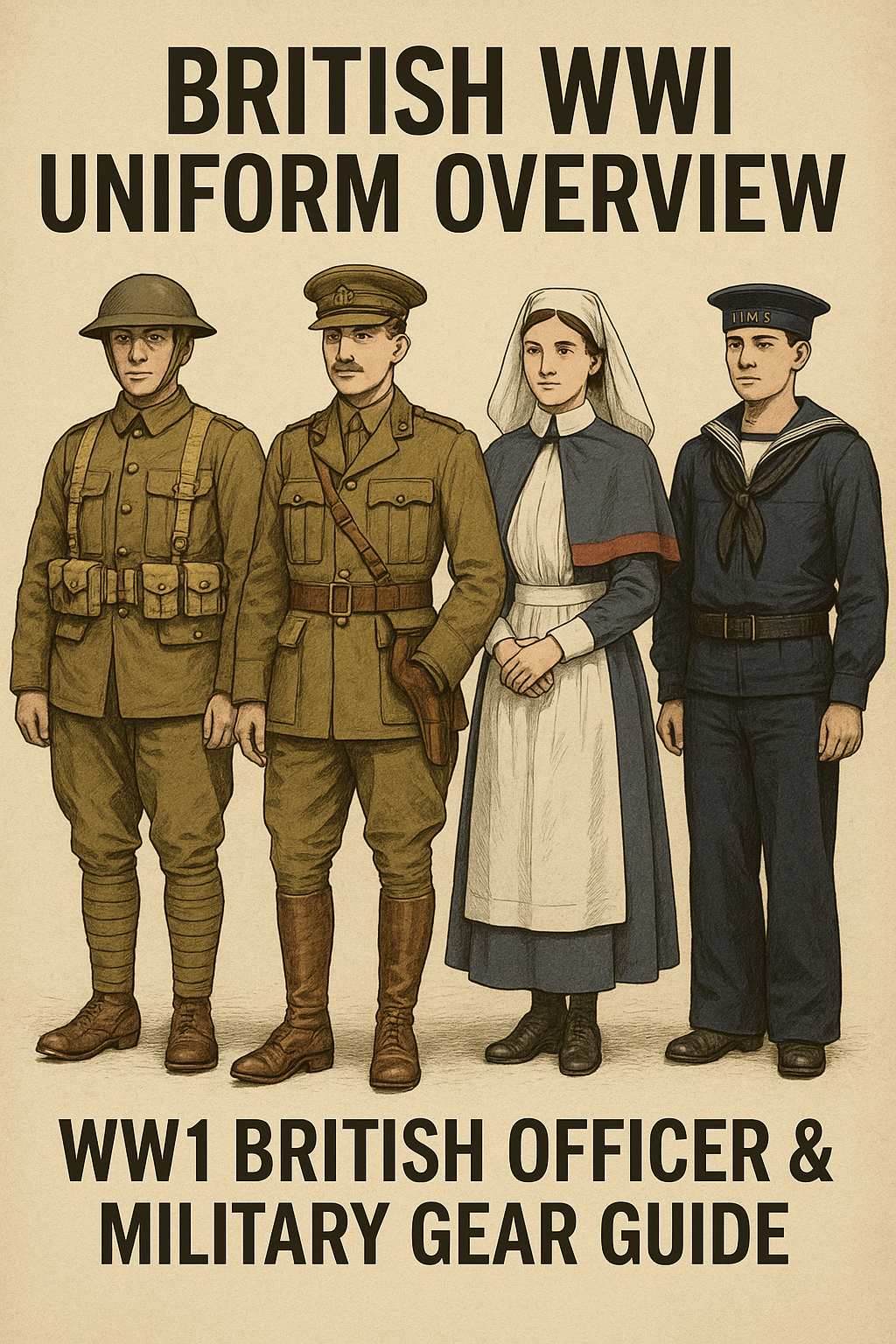
British WWI Uniform Overview | WW1 British Officer & Military Gear Guide
Published on Jul 02, 2025
British WWI Uniform Overview: A Complete Guide to First World War
The First World War (1914–1918) dramatically transformed the nature of warfare and military dress. The British WWI uniform underwent several changes throughout the war, reflecting strategy, environment, and technology shifts. This guide provides a comprehensive look at the standard issue British military uniform during the Great War, with insights into officer gear, nurses' attire, naval dress, and global counterparts like the WWI Australian and US Navy uniforms.
The Khaki Revolution: Birth of a Practical Battlefield Uniform
Before WWI, British soldiers wore bright red coats—an iconic but impractical choice for modern warfare. With the outbreak of war, the British Army adopted khaki (derived from the Hindi word for "dust") as the standard color. This drab shade blended better with the muddy trenches of France and Belgium.
Key features of the WWI British enlisted uniform included:
- Service Dress Tunic: A wool tunic with four pleated pockets, a high collar, and brass buttons.
- Service Dress Trousers: Made of matching wool, cut straight with a button fly.
- Puttees: Long strips of cloth wrapped around the lower legs to protect from mud and trench foot.
- Ammunition Pouches & Webbing: Worn as part of the 1908 Pattern Web Equipment, used to carry gear.
- Brodie Helmet: Introduced in 1915, this steel helmet replaced the soft cap to offer head protection from shrapnel.
WWI British Officer Uniform: Class & Command on the Frontlines
British officers wore similar service dress to enlisted men but with finer tailoring and some distinctive features. Uniforms were often privately purchased, allowing for slight personal variation.
Characteristics of the WWI British officer uniform:
- Sam Browne Belt: A leather belt with a shoulder strap carrying a pistol and sword.
- Rank Insignia: Displayed on the cuff or epaulets, helping distinguish ranks in the field.
- Trench Coats & Capes: Officers often wore waterproof coats or wool capes for warmth and rain protection.
- Peaked Cap: Officers retained the traditional peaked service cap, while many soldiers switched to the Brodie helmet in active zones.
The officer uniform reflected authority and often came at personal expense—highlighting the social class divide within the military ranks.
WWI British Nurses Uniform: Compassion in Uniform
The contribution of women, especially nurses, was monumental during WWI. Nurses serving in organizations like the Queen Alexandra’s Imperial Military Nursing Service wore uniforms that balanced practicality with professionalism.
Features of the First World War nurses' uniform:
- Dark Blue Dresses: Modest, long-sleeved garments designed for functionality.
- White Aprons & Collars: Clean and stark against the dark blue, symbolizing hygiene.
- Red Capes: Often lined with grey, these wool capes became an iconic part of the British WWI nurse look.
- Caps or Veils: Differed depending on the nursing corps, rank, and service location.
These uniforms were more than dresses—they represented the vital and tireless role women played in saving lives on the battlefield.
WWI Navy Uniforms: British & U.S. Naval Attire in Contrast
At sea, uniform standards remained distinct. British Royal Navy uniforms retained their pre-war appearance, steeped in tradition and symbolism.
Elements of the WWI Royal Navy uniform:
- Double-breasted Jackets: Dark navy wool with brass buttons bearing the royal insignia.
- Bell-bottom Trousers: Designed for quick removal if a sailor fell overboard.
- Sailor Collar & Cap: Traditional design for enlisted sailors.
In contrast, the WWI US Navy uniform (also influential at the time) featured:
- Blue wool jumper with white piping
- Dixie Cup cap and neckerchief
- White summer uniforms for warmer climates
This comparison underscores the global evolution of naval attire during WWI, influenced by functionality and national identity.
WW1 Australian Uniform: Commonwealth Brotherhood on the Western Front
Though part of the British Empire, the Australian Imperial Force (AIF) wore uniforms with unique national traits.
Components of the WW1 Australian uniform:
- Slouch Hat: The iconic wide-brimmed hat, turned up on one side, was emblematic of Australian troops.
- Khaki Drill or Wool Service Dress: Similar in color to British uniforms but often adapted for harsh climates.
- Rising Sun Badge: Worn proudly on hats and uniforms, this symbol represents Australian military heritage.
- Puttees and Webbing: Australian troops used standard webbing and leg wraps like the British.
Despite the similarities, the Australian uniform had its own identity, shaped by its soldiers' rugged character and distinct culture.
WWI Uniform Legacy & Collectibility
Today, the WWI British uniform is a popular subject among collectors, reenactors, and historians. Authentic pieces, especially WWI British officer uniforms and nurses’ capes are highly sought after. Uniform replicas remain in demand for museum exhibitions, film productions, and living history events.
For enthusiasts, studying these uniforms offers a deeper connection to the personal experiences of those who served. Understanding the visual differences in rank, role, and nationality also helps us appreciate the complex social fabric of the wartime military.
Conclusion: More Than Fabric – The Story of WWI in Uniform
The British WWI uniform was not just military attire but a reflection of duty, courage, and change. From muddy trenches to hospital wards and stormy seas, the uniform tells a story of evolution in the face of modern warfare. Whether you're interested in the crisp lines of a British officer’s tunic or the striking red cape of a WWI nurse, each piece speaks volumes.
At Paddelaters.com, we proudly preserve and present these pieces of history. Our curated collections and detailed guides help keep the memory of the First World War alive—one uniform at a time.
